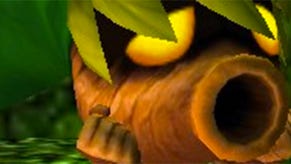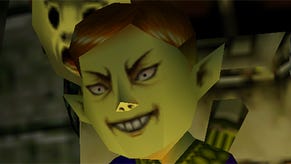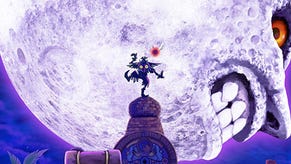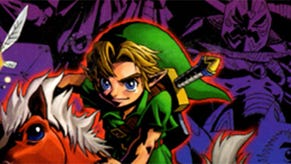USgamer Club: The Legend of Zelda: Majora's Mask 3D Part 3 — The Final Countdown
Our Majora's Mask playthrough comes to a close as Bob goes from Ikana Canyon to the moon. Join in on the discussion!
This article first appeared on USgamer, a partner publication of VG247. Some content, such as this article, has been migrated to VG247 for posterity after USgamer's closure - but it has not been edited or further vetted by the VG247 team.
Hello again, and welcome to another edition of USgamer Club! As with Kat's approach to Suikoden II, I'll be asking for and responding to your thoughts as we play through the entirety of The Legend of Zelda: Majora's Mask 3D. Since you're currently reading the last installment for this particular game, I won't be able to address your comments within the article itself, but I'm definitely going to be keeping an eye on the comments section below. Thanks again for following along, and if you need to catch up, be sure to check out the first two parts of our Majora's Mask 3D USgamer Club!
[Note: For the sake of convenience, the images in this article are from the original N64 version of Majora's Mask. (Courtesy of Zeldapedia.)]
Out of all the possible settings within The Legend of Zelda, it's hard to think of any quite as dark as Ikana Canyon. (Though I'm sure some of you kind commenters can prove me wrong.)
A barren wasteland that once hosted endless war, and now calls a few living humans its only residents—one being a deranged scientist who experiments on the undead? If I didn't know any better, I'd say this was Dark Souls. But no, here we are in Majora's Mask's Ikana Canyon, which takes the few horror elements of Ocarina of Time and expands on them within an interconnected area. While the destroyed Hyrule Castle Village and the well dungeon gave the previous Zelda a good dose of spookiness, Majora's doubles down on this aspect by making the forsaken Ikana Canyon a more significant part of the game. And frankly, it's still kind of a novelty to see Zelda go so dark—I remember being really confused when Wind Waker had its infamous reveal and people were up in arms about never getting their "mature Zelda."

Unlike the last two temples, making your way to the Stone Tower requires a much less direct route. To get there, you'll need to beat the Gorman Bros. in a race to win the Garo Mask—necessary for entry into Ikana Canyon—then visit the graveyard on the first night in order to learn the Song of Storms—which, as with Ocarina of Time, has only a few applications. You'll need this song to access Pamela and her father's lab for the next piece of the puzzle, which involves playing the Song of Healing in front of her zombified papa to get the Gibdo Mask; this item lets Link talk to their mummified kind, and also causes those dangerous Redeads to dance whenever he's in their presence—definitely stripping some power from Ocarina's most terrifying enemies.
Once you've gained the power to speak Undead, Link can then make his way through a mini-dungeon that's kind of filler-y—and one which may remind you of a past Nintendo game. EarthBound's Monkey Cave operates around the exact same gimmick: find the very specific thing for whoever's guarding the door you want to exit. Luckily, you can locate most of the Gibdos' needs without having to exit the dungeon itself (most of their needs being dungeon-related).
And so, after picking up the Mirror Shield, we're finally at the last proper temple of Majora's Mask, which, 15 years later, still has me feeling a little conflicted. Since there's no transformation mask in Ikana Canyon, the Stone Tower operates around an entirely different gimmick: The Elegy of Emptiness. While the Deku, Zora, and Goron forms each offer their own speedy travel options through air, sea, and land (respectively), the Elegy simply lets you create statue versions of each of these forms—with one of them being absolutely useless. It's a power that's used primarily so Link can apply pressure to one switch at once, though I'd much rather it be mapped to an item or mask ability instead of a song; entering the Stone Temple, for example, means you'll have to play the Elegy three times, and you'll do the same for an in-temple puzzle encountered early on. It kind of makes me wonder if Eiji Aonuma and his team had another transformation mask in the works, but had to scrap it for the sake of development time. Who knows if we missed out on Poe Link or Garo Link? Whatever the case, the implications behind that eerily realistic human Link statue you can leave behind could make up for the lack of an entirely new form.
The main gimmick of the Stone Tower can be found in how you eventually gain the power to flip its geometry upside down. On paper, I love the idea, but I don't think Majora's executes it all that well—in fact, Twilight Princess' Magnet Boots (or whatever they're called) make the same concept more manageable. For the most part, it was hard for me to recognize previously-explored rooms when I flipped them upside-down, though it doesn't help that the whole "room-flipping" thing can only be done via a handful of prescribed switches. Based on what I've read about the Stone Tower, it seems very much like Ocarina of Time's Water Temple: confounding for some, and a healthy challenge for others. Both dungeons ask the player to internalize various states of a 3D environment, which never caused me a problem in Ocarina, but had me taking more than one stab at the Stone Tower in Majora's. Thankfully, this dungeon caps off with a relatively easy boss fight against Twinmold, which will net you one of your final masks—one you can only use during that boss fight. After cleaning up your remaining side quests, one destination remains: the very tower that launched you from Clock Town into its strange surroundings.
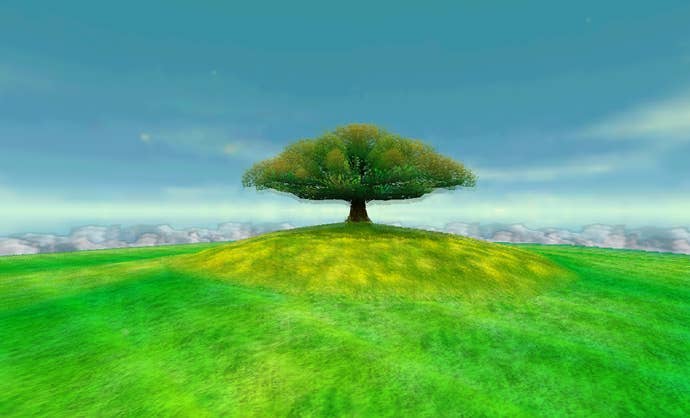
Once you have the four boss masks, visiting the Clock Tower on the Third Night yields one major change: The Four Giants, now empowered, use their combined power to stop the moon from falling altogether. Following this, Skull Kid beams his way to the moon, and Link follows—though if you're expecting it to be as barren and craggy as the glowering face constantly lingering in the sky, you'd be rudely mistaken. The surface of this moon takes the form of an idyllic meadow, with a huge tree at its center, and children playing around it—possibly hinting that, beneath Majora's Mask, Skull Kid hasn't completely lost his innocence. Whatever the case, it's definitely one of the most unexpected settings I've experienced in a video game. The dungeon to follow, unfortunately, feels a little perfunctory, and without a strong identity; really, it's a series of "tests" that judges how much the player knows about Link's four forms. Similarly, the battle with Majora's Mask itself doesn't feel all that special: Typical for a Japanese end-boss, it goes through several different phases, but the evil it inflicts throughout the course of Termina's final three days feels much more significant than any boss fight ever could.
That's okay, though, because Majora's Mask offers one of the best endings of the series. If you're able to solve a character's problem via the Bomber's Notebook throughout the course of the game, Majora's Mask's finale briefly follows up on them and their lives in a thoroughly undoomed world. Like Final Fantasy VI's ending, Majora's Masks' is modular, so getting the best one involves filling out that Notebook to the best of your abilities. Even if you don't manage to help everyone out, though, that "Dawn of a New Day" caption should give you goosebumps, regardless: After so many cycles of impending doom, it's heartwarming to know the citizens of Termina can finally get on with their lives.
So there we have it: Majora's Mask, in its entirety. And while I definitely picked up on some of its weaknesses this time around, I still feel this format doesn't have to be limited to a single game: I can only wonder what the Zelda team could do with the same time-loop setup and more than a year of development time. But even if Majora's Mask remains wholly unique with its formula, I won't be disappointed; though I've long since memorized the schedules of Termina's residence to point where they're less convincingly "real," I still appreciate its overall kookiness: with Ocarina already out, Aonuma and his team no longer had to prove themselves, so they just had fun—or whatever version of "fun" that's humanly possible with such a fast-tracked project. (My guess is Majora's Mask's weirdness was a side-effect of the dev team trying to keep themselves entertained.)

Nearly 15 years after its release, it's refreshing to know Majora's Mask is no longer the "black sheep" of the Zelda family; though it didn't have the kindest reception back in 2000, this 3DS release has brought it nothing but acclaim—especially from those who didn't give it a chance the first time around. My only hope is that the one-two punch of A Link Between Worlds and Majora's Mask 3D—released roughly within a year of each other—shows Nintendo that messing with the Zelda formula shouldn't be verboten. If anything, this more atypical form of Zelda has brought me back to the series in ways that Twilight Princess and Skyward Sword never could.


